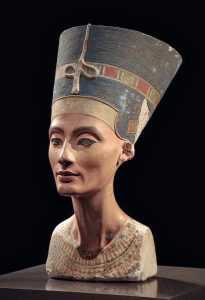Transmutation
by Jürgen Hoth
Nefertiti and AI
Dedicated to all children and their promising creativity–unbearably lost forever in wars around the world.
Abstract
The aim of this chapter is twofold, to explore the power that AI has to represent the same iconic image as transformed by a spectrum of art movements; and to assess the extent of potential graphic biases related to the use of AI. The central image used in this analysis was the bust of Nefertiti. This well-known image of beauty was transmuted by AI according to 22 different art movements and artists´ styles, ranging from Cave Art, Olmec and Maya art, passing through the Renaissance, Realism, and Surrealism, including contemporary artists with Warhol, Basquiat, Banksy, and indigenous artists from Panama and Mexico. The key technical and aesthetic results include: 1. Among nine sampled AI engines, DALL·E mini stood out for being the most accessible, reliable and safest for educational purposes. 2. As expected, it was possible to associate distinct outputs to the specific artwork but only in10 out of the 22 sampled artists and art movements, and this befell mostly to the artwork related to modern and contemporary styles. 3. Contrary to what was expected, no discernible biases were identified in terms of the dataset, representation, culture, gender, or concepts of beauty. A potential limitation of AI found through this exercise is picking up subtle aspects of humour and political critique –representing perhaps the last resisting strongholds of distinct human intelligence.
Introduction
Artificial Intelligence (AI) has taken the world by a whirlwind. The unbridled possibilities offered by the power of words automatically transmuted into new images –tapped from the wealth of human art production– are staggering. As with any other tool, however, it is up to its user to learn how to make the best use of it–hopefully in the advancement of “humankindness.”
This novel approach for generating baffling, credible and potentially inspiring images, is the work of a rapidly growing number of graphic AI engines that tap from the immense datasets available on the Internet. This information, as processed by any given AI engine, allows the creation of new content, resulting in images that resemble the training data but are not identical to it.
To make wise use of this powerful instrument, however, it is important to be aware that its results might be spiked by biases. As highlighted by Cade Metz (2019),[1] the NYTs technology reporter: “Researchers say computer systems are learning from (…) digitized books and news articles that could bake old attitudes into new technology” (my emphasis added).
Some of the main AI potential biases include: 1. Dataset, AI could favor some cultures, traditions, or styles; 2. Representation, including skin tone, facial features, or body types; 3. Culture, AI-generated art may reinforce racial stereotypes; 4. Gender, AI could potentially reinforce traditional gender roles or stereotypes; and 5. Beauty, AI can perpetuate harmful stereotypes or unrealistic beauty standards.[2]. It is important to acknowledge, though, that the producers of some AI engines, like DALL·E mini, recognize that their images “may also reinforce or exacerbate societal biases (…) given the fact that the model was trained on unfiltered data from the Internet, it may generate images that contain stereotypes against minority groups”. Importantly, they also highlight that they are working to analyze the nature and extent of these limitations. [3]
Hence, the thesis of this work is that AI can be a useful educational tool to become acquainted with the distinctive traits of the various art movements throughout its history, but its results can reflect biases.
To address this thesis the questions that will serve as a guide are:
- What is AI performance in terms of creating oeuvres that can be distinctly recognized according to its artistic movement? and
- What biases are consistently prevalent in the resulting AI imagery?
Approach
Three main steps were followed related to the process of technology and art selection, namely, 1) the choice and selection of AI engine; 2) the choice of the iconic piece to be used as a reference and follow its transmutation by AI; and 3) the selection of the artistic styles, with which this author is more familiar with, ranging from Cave to Pop Art. The results were then analyzed considering the criteria proposed by Lupescu (2023)[4] to assess the capabilities, performance and bias-related features of the chosen AI engine.
Choice of AI engine
The preliminary conditions for ensuring safe and open access were as follows: the AI engine had to 1) be free; 2) not demand personal information; 3) produce aesthetically interesting results; 4) be accessible; and 5) not require any programming knowledge.
From a list of nine popular AI engines [5] the only AI Engine that fulfilled the five conditions established above was DALL·E mini by craiyon.com.
Choice of focus figure: Nefertiti
Next, the idea was to simplify to the most possible the prompt used so that the effect of the artistic movement could be more easily and directly discernible in the result. The image of reference chosen was the iconic Egyptian Queen Nefertiti –by being perhaps one of the most recognizable and enduring emblems of beauty (Figure 1).
|
|
Figure 1. Bust of Queen Nefertiti (c. 1370 – c. 1330 BC) Limestone, height 48 cm, weight 20 kg. Nefertiti means ”The beautiful one Is here.” She was one of the consort queens of the pharaoh Akhenaton, 18th Dynasty of Ancient Egypt. This bust is housed in the Neues Museum in Berlin.[6] Photo by Philip Picard.[7]
Indeed, Nefertiti´s timeless beauty is an aspect that not even seasoned art historians such as Honour and Fleming, 2009: 91[8] can contain to praise as they consider this effigy as ”the most immediately arresting and memorable of all images of a highly sophisticated type of untouchable, female beauty,”
Two more aspects are important to keep in mind about this figure as AI´s output is evaluated. One is the ensemble of Nefertiti´s elongated neck and her facial expression associated with her high cheekbones, straight nose and full lips. The other is the headdress that symbolizes her status as Queen. This accessory consists of a tall, flattened crown featuring a blue headband adorned with the Uraeus which rests prominently on her forehead. The Uraeus is the symbol of royalty used in ancient Egypt represented by an erect female cobra evoking the burning and protective eye of Ra.[9][10]
Choice of prompt and artistic styles
After the choice of the focal image, Nefertiti, this name was used as the basis and common denominator in each prompt, where only the name of the artist or the movement was interchanged. Hence, the basic three-word prompt word used by DALL·E mini was:
Nefertiti Mondrian style
The word in italics was the only one replaced by one of the terms indicated in Table 1.
Table 1. Complete set of artists and art styles (chronologically ordered) and the respective prospective keywords interchangeably applied as part of the prompt used with DALL·E mini. The styles and authors shaded in orange were later eliminated due to their lack of resemblance to the original artwork, except Mola Panama, shaded in pink, which was included only in the discussion.
| Cave Art | Bruegel | Picasso | Basquiat |
| Ancient Egyptian | Gustav Courbet | Miró | Banksy |
| Maya | Seurat | Cubism | Mola, Panama |
| Olmec | Klimt | Pollock | Huichol |
| Greek | Matisse | Leonora Carrington | |
| Aztec | Mondrian | Warhol |
To have a graphic idea of how well the collection of the selected nine prompts covered the key artistic movements of the last 200 years, their names were highlighted in red in the art movement chart developed by Gompertz (2012[11]; Figure 2, below).
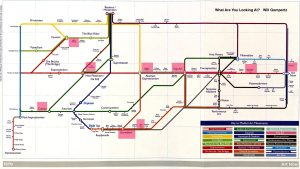
Figure 2. Chart of key Western artists and art movements of the last 200 years. The artists and movements highlighted in red are the ones that were selected in this essay. This chart emulates London´s underground train and was initially designed by Gompertz (2012).[12]
Choice of criteria to evaluate images produced by DALL·E
After initial trials with DALL·E mini and realizing the endless number of images it is capable of producing, the first criteria considered necessary to apply was for the images to be credible. As a working definition for this essay, “credibility” was here considered In terms of clearly showcasing the distinct traits and the essence of the artistic style of the respective authors and art movements. Moreover, additional potential criteria were taken into account based on the guidelines for the critical analysis of AI art as proposed by Lupescu (2023).[13] Based upon the aforementioned guidelines, a subset of criteria presented in Table 2, was selected on a preliminary basis as potentially helpful for the analysis of the images to be chosen.
Table 2. Main set of criteria taken into account to analyze the resulting AI imagery (based on Lupescu, 2023).[14]
| 1. Aesthetic and visual elements
3. Originality and creativity 4. Technical proficiency |
5. Technical Innovation
13. Cultural and regional influences 14. Process documentation |
21. Comparative. analysis
23. Artistic experimentation |
Finally, to put in perspective the appraisal of each set of images produced by DALL·E mini, a succinct text was added that summarizes the key aspects of the artwork (mostly concentrated in shape, color and composition) that characterizes each author or style. Unless otherwise referenced, the information in the text boxes was summarized from the information generated through ChatGPT by using the prompt “Characteristics of (author/style)´s art in 500 words.”
Results
In terms of the technical results, among the nine sampled AI engines, DALL·E mini stood out for being the most accessible for educational purposes. It was selected due to it being free, it does not request personal information, produces credible imagery and does not require programming knowledge. Moreover, through the preliminary trial testing of the 22 keywords indicated in Table 1, it was possible to note that the images produced by DALL·E mini are unrepeatable, i.e., the use of the same prompt in the same AI engine does not lead to the same results.
From an aesthetic perspective, the resulting images were mostly non-credible. In only 10 out of the 22 sets of images generated by DALL·E mini were credible in terms of offering the possibility of being unequivocally associated with a particular artist or style, as can be seen in figure 3.

Figure 3. Examples of indistinct outputs of images generated by DALL·E mini applying prompts related to different artists and art movements. Generic outputs such as these were excluded from the graphic analysis.
Only nine prompts, namely, Klimt, Matisse, Mondrian, Miró, Cubism, Pollock, Warhol, Basquiat and Banksy, were used in the analysis as their sets of images could be credibly associated with the style of each of these artists and movements (see figures 4 through 12, below). The only exception, and tenth prompt, that proved credible was the output related to Panama´s Kuna indigenous art, under the prompt “Mola, Panama” (see discussion, below).
The following are the outputs associated with each of the selected artists and styles.
Gustav KLIMT (1862 – 1918), Austria.
One of the defining characteristics of Gustav Klimt’s art is his use of elaborate ornamentation and intricate patterns. Klimt developed a highly decorative style characterized by the use of gold leaf, geometric shapes, and swirling motifs. He often depicted figures with elongated proportions and sinuous curves, emphasizing the sensuality and grace of the human body.
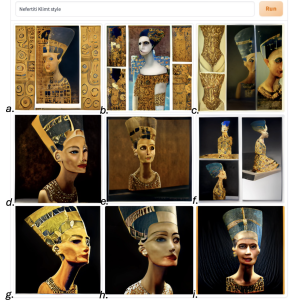
Figure 4. Images generated by DALL·E mini with the prompt “Nefertiti Klimt style”.
COMMENT: Most of the Klimt-related images generated by DALL·E mini (figure 6) highlight the use of gilded elements favoured by him. The full bodies of women depicted in particular in 6.b. and 6.c. seem to feature normal proportions.
Henri MATISSE (1869- 1954), France.
Henri Matisse’s art is characterized by its bold use of color, dynamic composition, and expressive brushwork. As he traversed various styles and movements, he embraced abstraction and distortion, simplifying shapes and flattening perspectives to create dynamic arrangements that emphasized rhythm and movement. A defining characteristic of Matisse’s art is his exploration of light and form, using chiaroscuro effects to sculpt and define his subjects. His paintings exude a sense of joy and optimism.
Additionally, Matisse drastically simplifies forms to the point of becoming pure –almost decorative– linear patterns. In some cases., he gets rid of perspective altogether. His work reminds the simplicity and innocence of a child´s work (Gomberich, 1995: 573;[15] Honour and Fleming, 2009:[16] 775)
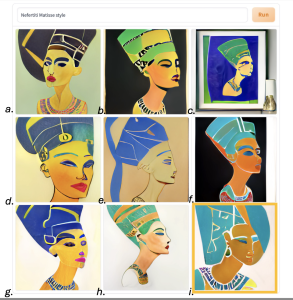
Figure 5. Images generated by DALL·E mini with the prompt “Nefertiti Matisse style”.
COMMENT. From this group of images, 5.i. is perhaps DALL·E mini rendition that conveys the best a Matisse-like countenance related to Nefertiti’s bust. Image 5. a. d. and f features what could be the ureaus.
CUBISM (1907-), France
Characterized by fragmented forms, geometric shapes, and multiple viewpoints. Cubism sought to represent the multidimensional nature of reality by depicting subjects from multiple perspectives simultaneously. Its emphasis is on the flat, two-dimensional surface of the canvas. Artists challenged the illusionistic depth of traditional painting, presenting instead objects and figures as flat, overlapping planes.
Cubist paintings often feature a muted color palette, with earthy tones and subdued hues.. Artists prioritized form and structure over naturalistic color, using color to define shapes and create spatial relationships within the composition. By reducing color to its essential elements, Cubist artists emphasized the underlying structure of their subjects and highlighted the geometric interplay of forms.
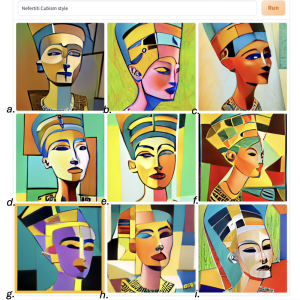
Figure 6. Images generated by DALL·E mini with the prompt “Nefertiti Cubism style”.
COMMENT: it is noteworthy that all DALL·E mini renditions of Nefertiti’s bust show the geometric component, but none of Picasso´s characteristic multiple perspectives. The images 5. d. and 5.e. seem to feature de uraeus,
Piet MONDRIAN (1872- 1944), Netherlands
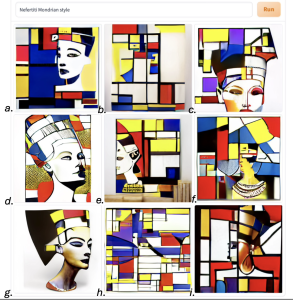
Figure 7. Images generated by DALL·E mini with the prompt “Nefertiti Mondrian style”.
COMMENT: These images could not have been included in this analysis by not being credible in that, according to ChatGPT “Mondrian did not paint faces in conjunction with his grid compositions” (the prompt used was “Did Mondrian paint faces together with his characteristic grid style?). Nonetheless, Mondrian would perhaps have agreed that image 6 b. adequately provided elements that may have conveyed his approach to Nefertiti´s bust, as suggested by the subtle inclusion of the form of an eye, in the middle upper part of the image.
Joan MIRÓ (1893-1983), Spain
Joan Miro´s works are celebrated for their playful, childlike forms juxtaposed with profound symbolism, reflecting his deep connection to his native Catalonia and his engagement with Surrealism and other avant-garde movements of his time. Miró’s art is characterized by a vibrant, whimsical aesthetic that often evokes a sense of wonder and spontaneity.
His use of bold colors, simplified shapes, and biomorphic forms creates a dreamlike atmosphere, inviting viewers into surreal and fantastical realms of imagination. One of his notable techniques is the incorporation of seemingly random splatters, drips, and lines, which add a sense of movement and energy to his compositions.
He often depicted enigmatic figures, such as stars, birds, and celestial bodies, which he imbued with symbolic significance. These symbols served as conduits for exploring universal themes of birth, death, and regeneration, as well as the interconnectedness of all living beings.

Figure 8. Images generated by DALL·E mini with the prompt “Nefertiti Miró style”.
COMMENT: This is perhaps the most playful transmutation that DALL·mini death of Nefertiti compared to all other cases. Perhaps in 8 g. there is still a likeness to Nefertiti while in 8 b., c., f., g. and i. it would be challenging to say that they represent the Queen´s bust.
Jackson POLLOCK (1912 – 1956), USA
Jackson Pollock´s “drip painting” or “action painting,” technique involved dripping, pouring, and splattering paint onto canvases laid out on the floor. Pollock’s paintings are characterized by their dense webs of interconnected lines, swirls, and drips, which create a sense of energy and movement. His compositions often lack recognizable forms or figures. He employed both thick impasto[1] marks and thin, delicate lines to create a sense of depth and texture within his paintings. His palette ranges from earthy tones to vibrant primaries.
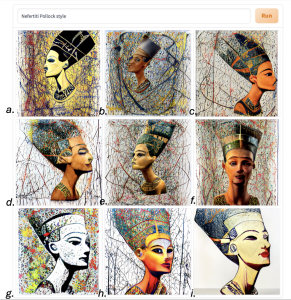
Figure 9. Images generated by DALL·E mini with the prompt “Nefertiti Pollock style”.
COMMENT: As with Mondrian (figure 7), these images evocative of Pollock´s drip artwork could not have been included in this analysis by not being credible in that, according to ChatGPT “Pollock did not incorporate faces into his characteristic drip painting style” (the prompt used was “Did Pollock paint faces together with his characteristic grid style?). It would seem, however, that Figure 9 g. would be perhaps the closest to an AI image generated considering a Nefertiti theme, with which Pollock would have been the least disgruntled. Only figures 9.f and 9.h. feature the Uraeus.
Andy WARHOL (1928 – 1987), USA
Andrew Warhola a.k.a. Andy Warhol´s works are characterized by a blend of consumer culture, celebrity, and mass production techniques He favors the concept of repetition with celebrity culture. Warhol’s art often explored themes of consumerism and commodification. Bold and vibrant hues, as well as bright, contrasting colors dominate his compositions.
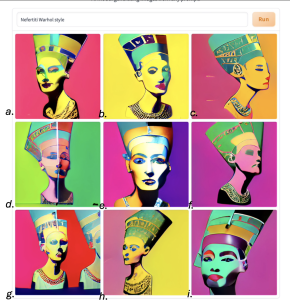
Figure 10. Images generated by DALL·E mini with the prompt “Nefertiti Warhol style“.
COMMENT: in this case, DALL·mini seems to have been Warhol´s alter ego. Probably he would have been pleasantly surprised by all these outcomes. It is particularly striking to see Nefertiti´s mischievous gesture, depicted especially in 10.a. and to an extent in 10. j., to an extent reminiscent of Warhol´s classic “Shot Red Marilyn” (1964).
Jean-Michel BASQUIAT (1960 – 1988), USA
Jean-Michel Basquiat developed a raw, expressive style and poignant exploration of identity, race, and society, blending elements of street art, graffiti, and fine art. He employed bold, gestural brushstrokes and vibrant colors. His paintings are filled with dynamic forms, swirling lines, and frenetic mark-making. He incorporated in his paintings words, phrases, and symbols from diverse sources, including history, literature, and popular culture. His paintings often feature recurring motifs such as crowns, skulls, and figures, which serve as symbols of power, mortality, and identity. Basquiat used street-inspired techniques such as spray paint, collage, and crude drawing.
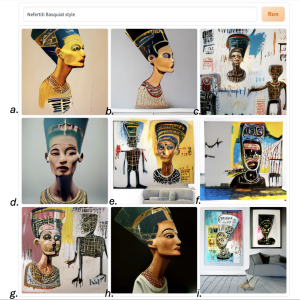
Figure 11. Images generated by DALL·E mini with the prompt “Nefertiti Basquiat style”.
COMMENT: the image presented in 10 f. Seems to be particularly striking and convincing of a type of work that Jean Michel Basquiat could have produced, as it transforms the exceptional naturalistic depiction (Honour and Fleming, 2009: 91)[18] of the white Egyptian Queen into that of a black impersonation à la Basquiat.
BANKSY (1990´s- ) UK
Banksy’s art is subversive by nature. He uses the urban environment as his canvas often featuring satirical and provocative imagery, juxtaposing familiar icons with unexpected elements to disrupt viewers’ expectations and provoke thought. Stencil graffiti is a hallmark of Banksy’s technique which provides a distinctive visual style of clean lines and bold contrasts.
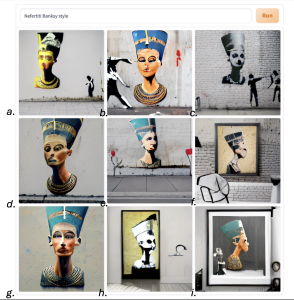
Figure 12. Images generated by DALL·E mini with the prompt “Nefertiti Banksy style”.
COMMENT: the elusive Banksy may perhaps find inspiration in some of the suggestions made by DALL·E mini. In particular, the one that may attract his attention the most is the image in 12 c., evocative of his classic stencil technique used in walls of cities around the world. Although the Street art approach is present in several of the renditions, none of them tell a story, or even suggest a glimpse of Banks’s characteristic subversion or thought-provoking approach. The uraeus is featured in five of the images.
Discussion
An unexpected finding that emerged at the end of preparing this essay was the controversy surrounding the use of Nefertiti’s image. For instance, after several years of legal battle, it was not in 2019 that the 3-D Scan of Nefertiti’s bust was publicly released by the Neues Museum in Berlin[19]. In terms of the photographical image, it was confirmed that the photo used in the introduction of this essay is licensed under Creative Commons as “free to copy, distribute and transmit.”[20]
In terms of AI performance, from a technical view of the nine sampled AI engines, DALL·E seems to be the most accessible and safest for educational purposes. It stood out by being free, not requiring personal information, producing credible imagery and by not requiring programming knowledge.
From an aesthetic view, in more than half of the distinct art cases (12 out of 22) DALL·E produced images that could not be attributed to any artist or style in particular. Most of the indiscernible output was related to ancient art but it also happened with more recent artists like Bruegel, Seurat and Courbet. This could be potentially associated with the Dataset bias, namely, that AI may favour some cultures, traditions, or styles; as could have been expected, favouring Western and modern painters. It is interesting to note, however, that DALL·E did interpret well Nefertiti as a typical embroidery (mola) made by Panama´s Kuna indigenous women as can be seen in figure 13). This exception shows that rather than a Cultural bias, the Dataset bias could be probably more related to the amount of information in the data bank currently available to DALL·E.
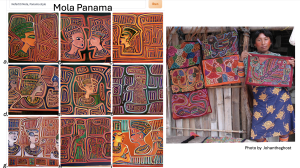
Figure 13. Left, images generated by DALL·E mini with the prompt “Nefertiti Mola, Panama style”. Right, indigenous, Kuna woman from the Kuna Yala islands on the Caribbean side of Panama. She is holding and exhibiting the traditional molas with geometric patterns as well as animal and plant patterns (Source WikiCommons)
In terms of the second bias, that of Representation, which refers to skin tone, facial features, or body types. in the here-obtained results, the tone of Nefertiti skin was depicted from white to black passing through the full spectrum of colours (see for instance the output related to Pollok and Warhol, figures 9 and 10, respectively). Additionally, the facial features were kept consistent and the characteristics of the body type were not grossly altered. This means that this bias was not present in this sample of 200 images..
The third potential bias is Culture, where it could be expected that AI-generated imagery could reinforce racial stereotypes. This was not the case either. If anything, it was very interesting how AI dealt with race, for instance, in the case of Basquiat –the only black artist in this essay who frequently represented Black people in his paintings– AI represented Nefertiti as a black character in five out of the nine images in his set (Figure 11). This seems to indicate that AI responded to the racial content characteristic in Basquiat´s work.
In terms of gender, this fourth bias is where it could be expected that AI could reinforce traditional gender roles or stereotypes present in the training data. Keeping in mind that Nefertiti was one of the most powerful women in her time within Egyptian society, throughout all of the artists´ and movements´ representations, her poise and sober countenance was maintained, and her role was not changed or diminished in any way. Thus, this bias was not seen in this sample of 91 images.
The fifth bias beauty, where it could be expected that AI could perpetuate harmful stereotypes or unrealistic beauty standards, for instance, exaggerating secondary sexual characteristics, like oversized breasts,[21] this aspect was not identified in any of Nefertiti’s representations, not even where her full body was presented, as was the case in Klimt´s set of images (figure 4).
Lastly, although AI produces remarkable results, some of the challenging areas seen in this collection of images seem related to aspects of emotional human nature, namely, humour (seen only in some of Warhol´s representations), and political critique, inherent to Banksy´s work but not picked up by AI (see figures 10 and 12, respectively).
Conclusion
In agreement with the proposed thesis, AI can indeed be a useful educational tool as shown through its convincing and credible performance in terms of creating oeuvres that can be distinctly recognized according to its artistic movement.
Interestingly, however, the images here analyzed as produced by DALL·E mini didn’t show the expected biases that are frequently attributed to AI. Although biases are inevitable, the negligible cases obtained in this exercise may already be the result of the ongoing efforts carried out by DALL·E[22] to address these limitations.
AI can be an extremely useful tool but only if subservient to human intelligence. This means that, although AI helped to expedite and synthesize a wealth of information, both through DALL·E mini, used for that generation of images and ChatGPT, used in the description of the artists and their movements, in both cases, it was critical to intelligently discern chaff from grain in the generated information.
Lastly, a remaining feature that may be an enduring challenging area for AI is that related to picking up subtle aspects of humour and political critique –representing perhaps the last resisting strongholds of distinct human intelligence.
Biography
I am a BFA student in my second year in visual arts at the University of Ottawa. I am also a professional conservationist with a bachelor’s degree in Biology, UNAM (Mexico), and a master’s degree in Rural Development and International Planning from the University of Guelph. By formally venturing into the world of art I seek to complement my scientific and conservation work in the creation and promotion of artistic works and activities to raise environmental awareness and at the same time to achieve a greater impact in the communication of social and environmental problems. My main field of artistic interest is photography.
Footnotes
- Metz, Cade. “We teach A.I. systems everything, including our biases,” The New York Times, November 11, 2019. https://www.nytimes.com/2019/11/11/technology/artificial-intelligence-bias.html ↵
- Kenig, Nitzan, Javier Monton Echeverria, and Aina Muntaner Vives. “Human Beauty According to Artificial Intelligence.” Plastic and Reconstructive Surgery. Global Open 11, no. 7 (2023): e5153–e5153. https://doi.org/10.1097/GOX.0000000000005153 ↵
- DALL·E mini by craiyon.com. Bias and Limitations https://huggingface.co/spaces/dalle-mini/dalle-mini Accessed March 30, 2024. ↵
- Lupescu, Lucian. Possible Guidelines for a Critical Analysis of AI Art, 18 September 2023, https://asynonymforrambling.wordpress.com/2023/09/18/possible-guidelines-for-a- critical-analysis-of-ai-art/ ↵
- List of engines that were explored: 1. Artbreeder. https://www.artbreeder.com/ 2. Craiyon. www.Craiyon.com 3. DALL·E 3. https://labs.openai.com 4. DALL·E mini. https://huggingface.co/spaces/dalle-mini/dalle-mini 5. DeepArt.io. https://deepart.io/ 6. Deep Dream Generator https://deepdreamgenerator.com/ 7. Google's ImageFX https://aitestkitchen.withgoogle.com/tools/image-fx 8. Runway ML: https://runwayml.com/ 9. Stable Diffusion https://stablediffusionweb.com ↵
- Tyldesley, J. "Nefertiti." Encyclopedia Britannica, February 25, 2024. https://www.britannica.com/biography/Nefertiti. ↵
- Philip Picard, 2009, Creative Commons image https://commons.wikimedia.org/wiki/File:Nofretete_Neues_Museum.jpg ↵
- Honour, Hugh, and John Fleming. The Visual Arts : a History. Revised seventh edition. London: Laurence King Publishing, 2009. ↵
- Tyldesley, Joyce. "Nefertiti's Face: The Creation of an Icon." Harvard University Press, 2018. ↵
- null ↵
- Gompertz, Will. What Are You Looking at?: 150 Years of Modern Art in the Blink of an Eye. London ; Viking, 2012. ↵
- Gompertz, Will. What Are You Looking at?: 150 Years of Modern Art in the Blink of an Eye. London ; Viking, 2012. ↵
- Lupescu, Lucian. Possible Guidelines for a Critical Analysis of AI Art, 18 September 2023, https://asynonymforrambling.wordpress.com/2023/09/18/possible-guidelines-for-a- critical-analysis-of-ai-art/ ↵
- Lupescu, Lucian. Possible Guidelines for a Critical Analysis of AI Art, 18 September 2023, https://asynonymforrambling.wordpress.com/2023/09/18/possible-guidelines-for-a- critical-analysis-of-ai-art/ ↵
- Gombrich, Ernst, « Histoire de l’art. » Paris : Phaidon, 1995. XVIme edition (reimpression 2021) ↵
- Honour, Hugh, and John Fleming. The Visual Arts : a History. Revised seventh edition. London: Laurence King Publishing, 2009. ↵
- (Oxford Advanced Learner's Dictionary, accessed March 23rd, 2024 https://www.oxfordlearnersdictionaries.com/definition/english/impasto?q=impasto). ↵
- Honour, Hugh, and John Fleming. The Visual Arts : a History. Revised seventh edition. London: Laurence King Publishing, 2009 ↵
- Rea, Naomi “An Artist Has Won a Legal Battle to Force a German Museum to Publicly Release Its 3D Scan of an Ancient Bust of Nefertiti.” Artnet News, November 17, 2019. Accessed, March 30, 2024 https://news.artnet.com/art-world/3d-scans-museums-nefertiti-1706181 ↵
- Wikipedia. File:Nofretete Neues Museum.jpg Accessed March 30, 2024. https://en.wikipedia.org/wiki/File:Nofretete_Neues_Museum.jpg ↵
- Kenig, Nitzan, Javier Monton Echeverria, and Aina Muntaner Vives. “Human Beauty According to Artificial Intelligence.” Plastic and Reconstructive Surgery. Global Open 11, no. 7 (2023): e5153–e5153. https://doi.org/10.1097/GOX.0000000000005153[/footnote ↵
- DALL·E mini by craiyon.com. Bias and Limitations https://huggingface.co/spaces/dalle-mini/dalle-mini Accessed March 30, 2024. ↵

